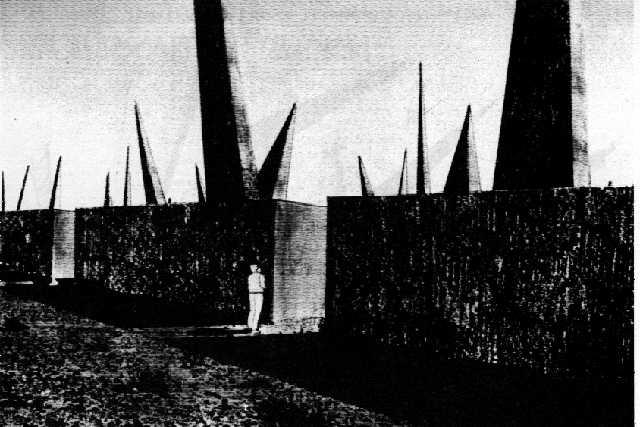
Effettivamente la foto del 25 Aprile si riferiva a Chernobyl.
Finora, il sarcofago di Chernobyl era additato come il più evidente monumento alla follia autodistruttiva dell’uomo, destinato ad essere conservato integro per migliaia di anni e utilizzato dagli oppositori del nucleare per dimostrare la sua pericolosità.
I fautori dell’energia nucleare, invece, sostengono, a ragione, che la centrale di Chernobyl era un impianto vecchio e insicuro, ma ora, negli Stati Uniti, additati come dimostrazione dell’esistenza di centrali sicure, è quasi completo un altro monumento a mio avviso ancora più folle, perché non è frutto di un incidente, ma di un pensiero lucido e razionale.
Si tratta del Waste Isolation Pilot Plant (WIPP), una discarica nucleare sotterranea situata nel deserto del New Mexico, profonda fino 2150 piedi (ca. 650 m).
Qui sono stati depositati per anni tutti i rifiuti radioattivi provenienti dalle centrali nucleari degli USA e quando sarà pieno (ed è quasi pieno) dovrà essere sigillato definitivamente.
Certamente il WIPP è sicuro. Test continui anche di terze parti, hanno dimostrato che nessuna radiazione sfugge dal deposito sotterraneo e si può anche camminarci sopra in assoluta sicurezza. Se è per questo, ci credo, ma il punto non è questo.
Il punto è che, dal momento della chiusura, sarà necessario segnalare chiaramente che chi scava qui, muore. E non solo: scavando si potrebbe aprire un vaso di pandora in grado di avvelenare una vasta area, prima che la fonte venga identificata e richiusa.
Fin qui niente di strano. Il governo americano è certamente in grado di impedire l’accesso all’area. Il problema, però, sta nel fatto che questo divieto dovrà essere mantenuto per almeno 10.000 anni, tale è il periodo di tempo necessario perché le scorie diventino relativamente innocue.
10.000 anni sono un periodo di tempo inimmaginabile. I monumenti più antichi che abbiamo, le piramidi, esistono dalla metà di questo tempo.
Il problema che i tecnici stanno affrontando è di far sì che questa informazione vitale venga tramandata e si conservi intatta per questo inimmaginabile periodo di tempo.
Guardate questa immagine:

Per noi è chiarissima, ma cosa dirà ai nostri discendenti anche fra “soli” 3000 anni? Come sarà la razza umana fra 10000 anni? Come progettare un messaggio che mantenga intatto il suo significato nonostante le inimmaginabili differenze culturali che si produrranno?
Se ne è occupata la Sandia Corporation, producendo un suggestivo rapporto in cui si immagina di costruire strutture che evochino un senso di pericolo, come quella nell’immagine di apertura. Suggerimenti solo in parte accolti dal governo, che ha optato per soluzioni più tradizionali, ma qualsiasi soluzione, a mio avviso, è insufficiente di fronte alla curiosità umana.
Così come le maledizioni e le iscrizioni non ci hanno impedito di entrare nelle tombe dei faraoni, nessuna struttura è in grado di impedire che i nostri lontani discendenti cerchino di capire cosa c’è lì, anzi, per me, la presenza di costruzioni strane e uniche come quelle proposte nel rapporto di cui sopra, sarebbe solo un incentivo a scavare.
Category Archives: Usa
Tenete lontani i vostri bambini

Boing Boing riporta una trasmissione radio della NPR in cui viene descritto questo interessante ordigno, sviluppato dalla Integrated Wave Technologies, che i soldati americani utilizzano per “comunicare” con gli indigeni (nella fattispecie, gli iracheni).
Si tratta di un traduttore che capisce un numero limitato di frasi ed è in grado di ripeterle in 15 lingue, spesso in forma più dettagliata.
Quello che mi colpisce è il tono della descrizione. È per questo che ho scritto “comunicare” fra virgolette. Dice:
Per esempio, quando il soldato dice una semplice frase come “keep kids back”, il Voice Response Translator (VRT) traduce in arabo accrescendo il dettaglio. In questo caso, la traduzione è “Tenete i vostri bambini lontano da noi o intraprenderemo delle azioni contro di voi”
il che, detto da un marine che, come minimo, ti tiene un M16 puntato addosso, è estremamente rassicurante, favorisce il dialogo e lo stabilirsi di un clima di fiducia.
La dichiarazione del produttore è ancora più allucinante:
Comunicazioni semplici come questa possono salvare vite, sia fra i civili che fra i militari. Questo elimina il tirare il grilletto come prima opzione nel trattare con gli indigeni.
Maledizione, io capisco che in guerra sia utile impartire istruzioni chiare ai civili e magari questo oggetto serve, ma un po’ di diplomazia, no? Forse “tenete i bambini in casa, qui è pericoloso” sarebbe stato meglio.
E l’ultima frase significa forse che senza il VRT, la prima opzione è tirare il grilletto?
I consulenti per la comunicazione che gli USA pagano profumatamente, cosa ci stanno a fare? E chi sono?
Force Quit

Hi, hi, hi….
Quello in foto è l’ormai ex segretario alla difesa e artefice della strategia USA in Iraq, Donald Rumsfeld.
Da Boing Boing.
L’uomo nuovo è un ex capo CIA e questo significa che è iniziata la resa dei conti. L’Agenzia si prende la rivincita nei confronti del Pentagono, dopo essere stata messa da parte da Bush fin dal momento del suo insediamento.
Pochi, infatti, ricordano che, quando, all’arrivo del nuovo presidente, i rappresentanti delle varie agenzie sono andati alla casa bianca presentando i propri piani e i propri desiderata, Bush ha scelto di finanziare il Pentagono, negando l’aumento degli investimenti in intelligence richiesto dalla CIA.
Ed è stato il suo primo, tragico errore (che, fra l’altro, fa pensare che la CIA non abbia fatto molti sforzi per intercettare i kamikaze, anche per dimostrare che non poteva funzionare al massimo).
Inoltre, alla casa bianca ritorna il consigliere James Baker, sintomo della affermazione della corrente realista e pragmatica su quella fondamentalista all’interno dei repubblicani.
Sento ora che, dimissionando Rumsfeld, Bush lo ha elogiato “per aver lanciato una campagna innovativa in Iraq”. Ma chi glieli scrive i discorsi?
Scrivere a mano?
Il Washington Post rivela che, negli esami scritti tenutisi nelle scuole americane nel 2006, solo il 15% degli studenti ha scritto in corsivo. E il rimanente 85%? Stampato. Tutto in maiuscoletto a lettere staccate.
La causa è attribuita al calo di istruzione nella scrittura manuale nella scuola di primo grado (le elementari) collegato anche all’avviamento precoce all’uso del computer.
Musical nationalism in USA?
The following data are taken from a reaserch by Bocconi Italian University.
In all European countries, the music market is shared between national and international songs. Even in France, where national culture is very important and supported by the government, 60% is french music and 35% come from abroad (the remaining 5% is classic music).
France has the highest ratio between national/foreign music in EU. The lowest is in Switzerland: 10% national, 90% foreign.
UK is one of the most important music makers in the world, but its market is equally shared: 47/47.
In the USA this ratio is 93/05. It means that the american people buy american music for 93% and foreign music for 5% only.
I know that the USA are a great music maker and the americans don’t like music not sung in english, but I would have expected a greater diffusion of UK bands in USA.
Now I have two questions:
- I remember a very different situation in the eighties. How much the America is changed?
- Is this a sort of musical chauvinism? The music is an important part of the culture. If the culture in USA is so self-centered, what kind of knowledge of outside world can the people have?
Winchester Mystery House

This is the story of a house. A big house that I’ve seen many years ago and that I had forgotten until some days ago, when I have read its name in a book about bob Dylan.
It’s the Winchester Mystery House, an infamous California mansion that was under construction continuously for nearly 40 years and is reputed to be haunted. Construction of the San Jose, California mansion began in 1884, financed by owner Sarah L. Winchester, the widow of gun magnate William Wirt Winchester. Construction continued 24 hours a day, seven days a week, 365 days a year, until her death 38 years later in 1922. The cost for such constant building has been estimated at about US$5.5 million.
The mansion is renowned for its size and lack of a master building plan. Sarah Winchester believed the house was haunted by the ghosts of individuals killed by Winchester rifles, and that only continuous construction would appease them. It is located at 525 South Winchester Blvd. in San Jose.
Sarah Winchester inherited more than $20 million upon her husband’s death. She also received nearly 50 percent ownership of the Winchester Repeating Arms Company, giving her an income of roughly $1,000 per day, none of which was taxable until 1913. This amount is roughly equivalent to $19,000 in 2005 dollars.
Deeply saddened by her husband’s death and seeking solace, she consulted a spiritualist on the advice of a friend. According to legend the medium (who has become known colloquially as the “Boston Medium”), told Winchester that there was a curse upon the Winchester family because the guns they made had taken so many lives. She told Winchester that “thousands of persons have died because of it and their spirits are now seeking vengeance.”
Although this is disputed, many believe the Boston Medium told her she needed to leave her home in New Haven and travel west, where she must “build a home for yourself and for the spirits who have fallen from this terrible weapon, too. You can never stop building the house. If you continue building, you will live. Stop and you will die.” Whether this tale is true or not, Winchester did move west, settling in California. Some believe Winchester followed the medium’s directions to distract the spirits she believed were hunting her. She was reported to have slept in a different room each night for some time.
Every night, Sarah would go to her Seance Room to receive messages from the spirits telling her what she should build. The orders from the spirits resulted in many strange constructions, such as doors that open onto walls, stairs that go nowhere, a cupboard that has only 1/2 inch of storage space, and tiny doorways and hallways just big enough for Sarah (who was 4’10” and of slight build) to fit through.
Prior to the 1906 earthquake, the house had been built up to seven stories tall, but today the highest point is the fourth floor. The house is predominantly wood frame construction, with a brick foundation. There are 160 rooms, including 40 bedrooms and two ballrooms. The house also has 47 fireplaces, 10,000 window panes, 17 chimneys (with evidence of two others), two basements and three elevators.
The house retains unique touches that reflect Winchester’s beliefs and her reported preoccupation with warding off malevolent spirits. The number thirteen and spiderweb motifs, which she considered to be lucky, reappear around the house. For example, an expensive imported chandelier that originally had 12 candle-holders was altered to accommodate 13 candles, wall clothes hooks are in multiples of 13, and a spiderweb-patterned Tiffany window contains 13 colored stones. In tribute, the house’s current groundskeepers have created a topiary tree shaped like the number 13.
Today, several different tours of the house are available, including flashlight tours at night on dates around Halloween and each Friday the 13th.
Here is a big aerial view of the house. This image shows the house’s size, but can’t reveal the construction’s complexity. This b/w image shows a closer look.
The house website
English text is taken from Wikipedia.
